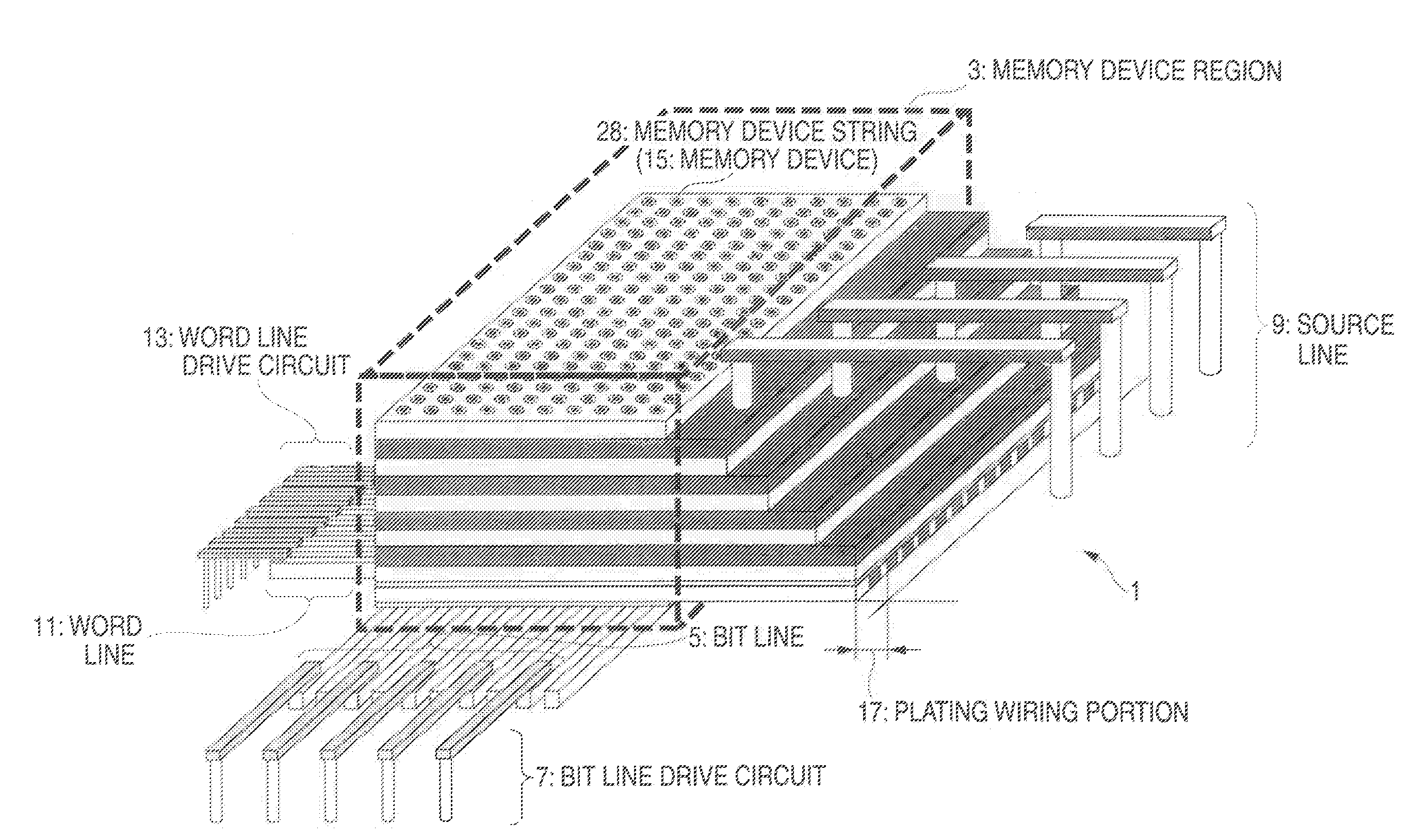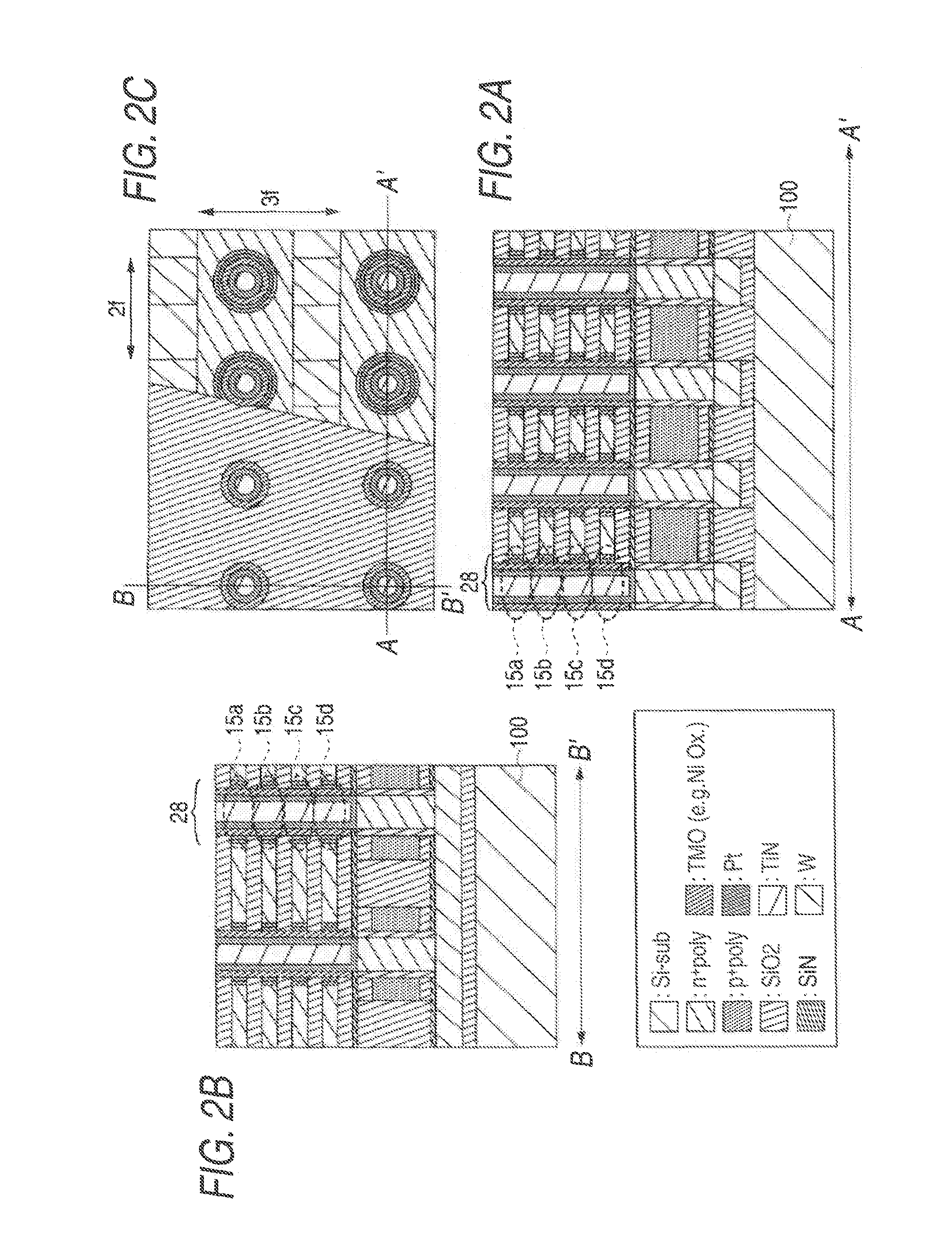Semiconductor memory and method for manufacturing the same
a technology of semiconductor devices and memory, applied in the field of semiconductor memory, can solve the problems of increasing the cost with an increase in the number of stacks, not being able to circumvent the minimum design rule, and becoming difficult to reduce the minimum design rul
- Summary
- Abstract
- Description
- Claims
- Application Information
AI Technical Summary
Benefits of technology
Problems solved by technology
Method used
Image
Examples
first embodiment
(Nonvolatile Semiconductor Memory 1 of Unipolar Operation)
(OxReRAM: Oxide Resistive RAM)
[0104]FIG. 1 shows the schematic configuration of a nonvolatile semiconductor memory 1 according to a first embodiment. The nonvolatile semiconductor memory 1 has a memory device region 3, bit lines 5, a bit line drive circuit 7, source lines 9, word lines 11, a word line drive circuit 13, etc. A plating wiring portion 17 of the nonvolatile semiconductor memory 1 according to the first embodiment indicates a portion cut after a plating process of the nonvolatile semiconductor memory 1. As shown in FIG. 1, in the nonvolatile semiconductor memory 1, memory devices 15 forming the memory device region 3 are formed by stacking semiconductor layers. As shown in FIG. 1, the source lines 9 of each layer are spread two-dimensionally. The source lines 9 of each layer have a plate-like flat structure made of the same layer. In the nonvolatile semiconductor memory 1, the direction of current flowing into the...
third embodiment
(Manufacturing Process of Nonvolatile Semiconductor Memory of Unipolar Operation)
(OxReRAM: Oxide Resistive RAM)
[0182]A manufacturing process of nonvolatile semiconductor memory 1 according to a third embodiment will be discussed with reference to FIGS. 41A to 48C. In the embodiment, to form a resistance change element forming a part of a memory device 15, the surface of a titanium nitride (TiN) silicide forming the resistance change element is oxidized. In the embodiment, plating wiring need not be formed because a plating process as described in the first embodiment is not required.
[0183]FIGS. 41A to 48C show each a part of the memory device region 3 of the nonvolatile semiconductor memory 1 according to the third embodiment as in the first embodiment. FIGS. 41C to 48C are top views of the memory device region 3. FIGS. 41A to 48A are sectional views of the memory device region 3 taken on line A-A′ in FIGS. 41C to 48C. FIGS. 41B to 48B are sectional views of the memory device region...
fourth embodiment
(PRAM: Phase Change RAM)
[0196]In a fourth embodiment, a nonvolatile semiconductor memory of phase change type using a phase change film of GST (GeSbTe), etc., (PRAM: Phase Change RAM) will be discussed as an example of nonvolatile semiconductor memory of unipolar operation.
[0197]FIG. 49 shows the schematic configuration of a nonvolatile semiconductor memory 200 according to the fourth embodiment. The nonvolatile semiconductor memory 200 according to the fourth embodiment has a memory device region 3, bit lines 5, a bit line drive circuit 7, source lines 9, word lines 11, a word line drive circuit 13, etc. A plating wiring portion 17 of the nonvolatile semiconductor memory 200 according to the fourth embodiment indicates a portion cut after a plating process performed in manufacturing the nonvolatile semiconductor memory 200. As shown in FIG. 49, in the nonvolatile semiconductor memory 200, memory devices 15 forming the memory device region 3 are formed by stacking semiconductor laye...
PUM
 Login to View More
Login to View More Abstract
Description
Claims
Application Information
 Login to View More
Login to View More - R&D
- Intellectual Property
- Life Sciences
- Materials
- Tech Scout
- Unparalleled Data Quality
- Higher Quality Content
- 60% Fewer Hallucinations
Browse by: Latest US Patents, China's latest patents, Technical Efficacy Thesaurus, Application Domain, Technology Topic, Popular Technical Reports.
© 2025 PatSnap. All rights reserved.Legal|Privacy policy|Modern Slavery Act Transparency Statement|Sitemap|About US| Contact US: help@patsnap.com



